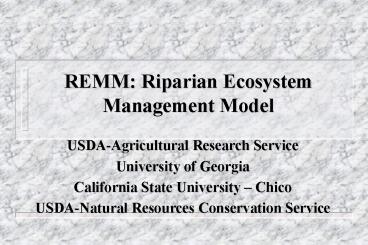REMM: Riparian Ecosystem Management Model - PowerPoint PPT Presentation
1 / 40
Title:
REMM: Riparian Ecosystem Management Model
Description:
California State University Chico. USDA-Natural Resources Conservation ... coniferous trees. deciduous trees. herbaceous perennials/ annuals. REMM: Vegetation ... – PowerPoint PPT presentation
Number of Views:73
Avg rating:3.0/5.0
Title: REMM: Riparian Ecosystem Management Model
1
REMM Riparian Ecosystem Management Model
- USDA-Agricultural Research Service
- University of Georgia
- California State University Chico
- USDA-Natural Resources Conservation Service
2
Outline
- Model Components
- Applications of REMM
- Integration with watershed models/other ongoing
work
3
REMM Components
vegetative growth
hydrology
nutrient dynamics
sediment
- Adding pesticides
4
Three Zone Buffer System
5
Riparian Ecosystem Management Model
- Quantify water quality benefits of multiple zone
buffers and account for - Climate (either real or synthetic)
- Slope (variable among zones)
- Soils (hydrologic, nutrient, carbon)
- Vegetation (above and below)
- loadings from nonpoint source
6
REMM Vegetation Types
coniferous trees
deciduous trees
herbaceous perennials/ annuals
7
REMM Vegetation
Upper canopy/lower canopy
Multiple vegetation types in both canopies based
on percent cover Any/all vegetation can be in
each zone
8
Phosphorus Pools in Soil and Litter
9
Nitrogen Pools in Soil and Litter
10
Litter and Soil Interactions in REMM
11
REMM Input Required
- Upland inputs daily surface runoff and
subsurface flow, associated sediment and
chemistry - Daily Weather Data
- Site Description
- Soil Characteristics
- Erosion Factors
- Vegetation Characteristics
12
REMM Documentation
- Coded in C, primarily by R.G. Williams
- Executable version available for download
- Editing tools to build data sets available for
download - Text of users guide available online
- Graphical user interface developed by
L. S. Altier at Cal State.
13
REMM Documentation
- Published as USDA Conservation Research Report
No. 46 in 2002. We have copies!! - General article on REMM structure with some
sensitivity analysis in JSWC - REMM tested (validation) in two articles in
Trans. ASAE - Applications of REMM for coastal plain systems
published in JAWRA and Trans. ASAE
14
Uses for REMM
- Predict load reductions for buffer scenarios
- Predict outputs to streams for different nonpoint
source loadings - Predict changes in pollutant transport processes
15
Uses for REMM
- Compare buffers with different vegetation
- Predict changes in pollutant removal mechanisms
- Examine behavior of riparian systems as
represented by REMM
16
Example - Buffer Scenarios
- 14 buffers ranging from minimum Zone 1 buffer (5
m) to 52 m three zone buffer - Simulated both conventional row crop loading
(normal) and dairy lagoon effluent loading
(high).
17
Loading Scenarios
18
Buffer Scenarios
19
Total Water Output
20
Total N Output
21
Total N load reduction
22
Sediment Output
23
Sediment Load Reduction
24
Use of REMM to Simulate Mature Buffer on Highly P
Loaded Soils(All values kg P/ha)
Residue Humus Labile Inorganic Active Inorganic Stable Inorganic
Litter Soil (Base) 17.5 398 130 244 1079
Litter Soil (High) 33 1448 1304 2445 10788
25
Long Term Phosphorus Losses from Buffer with
Highly Enriched Soil P
26
After about 500 years near background levels
27
Use of REMM to simulate mature buffer receiving
increased loadings of P
- Increase the P pools in buffer from measured
(base case) to 10x base case - Increase the dissolved P input in surface runoff
from measured (base case) to 10x base case
28
Use of REMM to simulate mature buffer receiving
increased loadings of P
Litter Soil (kg P/ha) (1x to 10x) Dissolved P Surface Runoff inputs (kg P/ha/yr) (1x to 10x)
1,868 to 18,680 6 to 60
29
(No Transcript)
30
(No Transcript)
31
Model nonpoint source pollution control by a wide
range of buffers
32
Future Work with REMM
- Integration with ARS watershed models SWAT and
AnnAGNPS - Testing with data from ARS buffer research sites
currently working on Beltsville site, Ames,
Corvallis, Coshocton, Florence, Oxford, Tifton,
University Park. - Addition of new components for pesticides to be
compatible with WS models - Consultation with diverse groups of users
33
Integration with SWAT
- Conceptually fits between upland sources areas
and channel processes. - Preliminary work plan developed between modeling
teams
34
Integration with SWAT
- Require surface and subsurface outputs from
source areas - Change from 3 zone to variable zone with default
of one zone. Alternatively, change to one zone.
35
Integration with SWAT
- Change as many variables as possible in
vegetation to default values. Remain as input
variables but automatically use default values.
36
Integration with SWAT
- Change from 3 layer to multiple layer, default
3. - Keep all the soil and litter pools.
- Initialize all soil carbon pools directly from a
soil organic matter value.
37
Integration with SWAT
- Initialize soil organic N and soil organic P
pools directly from SOC pools based on C/N and
C/P ratios. - Standardize temperature and water factors
38
Integration with SWAT - General
- Functions of riparian zones will vary with stream
order - Some will receive inputs from source areas
- Some will receive inputs from upstream watersheds
39
Integration with SWAT -Channels
- Can provide some dynamic inputs such as root
biomass and coarse woody debris inputs needed to
model streams and streambanks
40
Integration with SWAT - VFS
- Separate use for VFS from use for riparian
buffer? VFS could be based on field border area
rather than channel length. Riparian buffer
would be based on channel length and/or
hydrologic contributing area. How is water
delivered to the VFS or to the riparian buffer?
Does VFS put its water into the buffer? Is this
the same as a multiple zone buffer?































